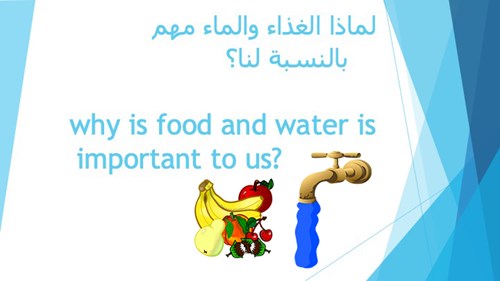By the end of Year 6, students use spoken and written Arabic to exchange personal information and describe people, places and ideas related to their personal experiences and social activities such as celebrations for example, أذهب مع عائلتي لزيارة جدي وجدتي في الأعياد؛ في العطلة الأسبوعية, sport (for example, أألعب رياضتي المفضلة مع أصدقائي بعد المدرسة في الحديقة العامة and other interests such as أشاهد أفلام الكارتون مع عائلتي في السينما؛ ألعب ألعاب إلكترونية. They make shared decisions, for example, أريد أن... , provide suggestions such as يمكن أن... , and complete transactions. When participating in classroom routines and activities, they follow shared rules and procedures, express opinions and ask for clarification, for example, حسنا؛ نعم ولكن؛ أعتقد أن...؛ ما معنى ... . Students use patterns of Arabic pronunciation and intonation when interacting. They locate, classify and organise information from a range of spoken, written and visual texts related to aspects of culture and lifestyle. They present ideas and information on topics of interest and aspects of culture in different formats for particular audiences. They respond to a range of imaginative texts by expressing opinions on key elements for example, من القصة نتعلم ال..., characters for example, أحب علاء الدين لأنه...؛ لا أحب الملك في الفيلم لأنه and actions for example, يجب على نيمو أن يسمع كلام أبيه, and making connections with own experience, for example أنا أيضا يجب أن...؛ أنا مثل... . They create and perform short imaginative texts based on a stimulus, concept or theme. They use a variety of tenses for example, الأفعال الماضية والمضارعة and apply verb conjugation for example,أكلتُ/أكلَ/أكلت, suffixes for example, أذهب/ يذهب/تذهب, basic conjunctions for example,و؛ أو and a range of adjectives for example, الصفة للمذكر والصفة للمؤنث للأشياء والأشخاص and adverbs for example, سريعاً؛ ليلاً؛ صباحاً؛ يوميًّا to construct sentences and to produce short texts. Students translate texts from Arabic into English and vice versa, identifying words that are not easily translated, such as أيفون؛ تلفاز؛ كومبيوتر , and create bilingual texts for their own learning and for the school community. They identify ways in which their own biography for example, السيرة الذاتية؛ الخبرات الخاصة, traditions for example, العادات العائلية والإجتماعية and beliefs for example, المعتقدات الخاصة impact on their identity and influence the ways in which they communicate in Arabic and English.
Students identify the role of vowels in softening and extending sounds and apply writing conventions to own constructions. They distinguish between the structure and features of different types of spoken and written Arabic texts and identify ways in which audience, context and purpose influence language choices and the form of Arabic used. They provide examples of how language use and ways of communicating vary according to the relationship between participants and the purpose of the exchange, for example, أنواع الجمل: الإسمية والفعلية؛ الترداد في بعض العبارات؛ طول الجمل والفواصل الشفهية فيها. They identify how languages influence one another, including the influence of indigenous languages of the Arabic-speaking world and regional languages such as Aramaic, Syriac, Phoenician, Persian, Kurdish and Turkish on Arabic, for example الأبجدية؛ المفردات المستعارة؛ أصل الكلمات. They give examples of how language use reflects particular value systems, attitudes and patterns of behaviour across cultures.





